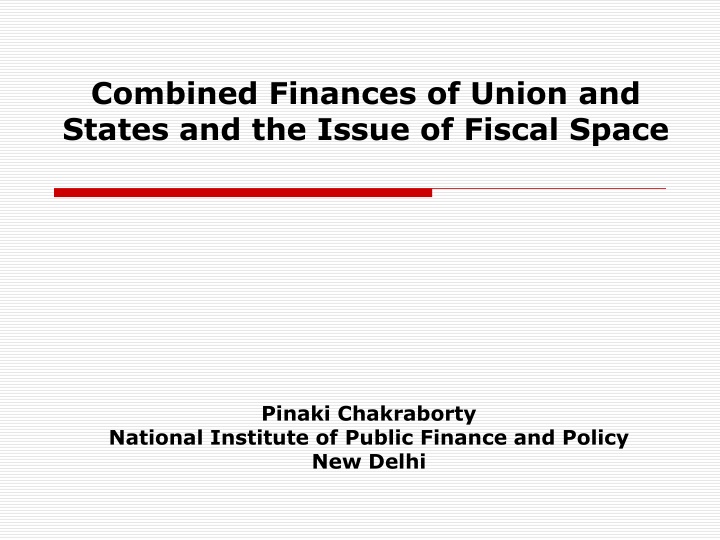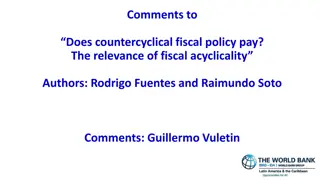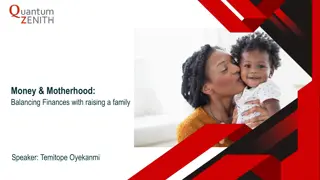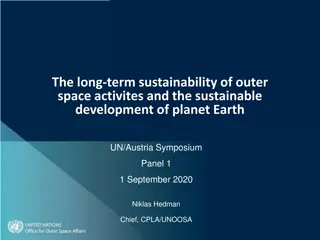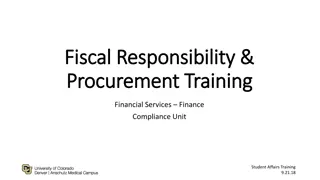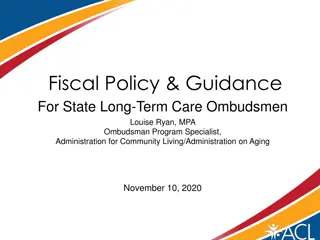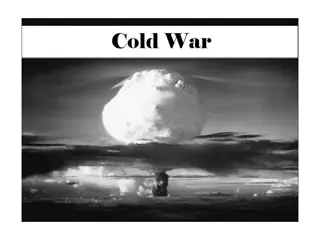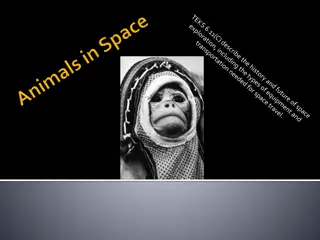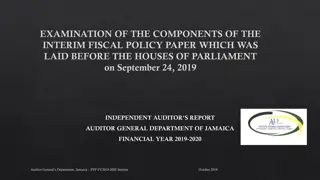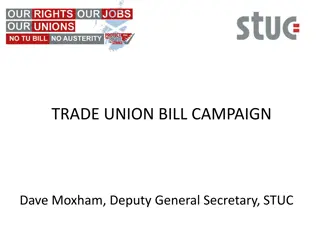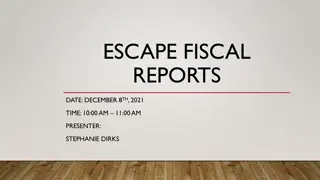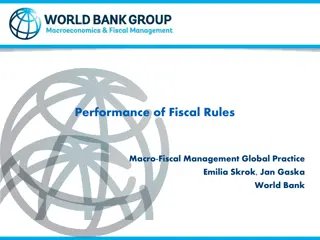Combined Finances of Union and States and the Issue of Fiscal Space
This study delves into the combined finances of the Union and different states, focusing on revenue and fiscal deficits, central transfers, tax devolution, grants-in-aid, and their impact on fiscal space. The analysis includes trends in aggregate central transfers and the changing composition favoring untied and formula-based transfers.
Download Presentation

Please find below an Image/Link to download the presentation.
The content on the website is provided AS IS for your information and personal use only. It may not be sold, licensed, or shared on other websites without obtaining consent from the author.If you encounter any issues during the download, it is possible that the publisher has removed the file from their server.
You are allowed to download the files provided on this website for personal or commercial use, subject to the condition that they are used lawfully. All files are the property of their respective owners.
The content on the website is provided AS IS for your information and personal use only. It may not be sold, licensed, or shared on other websites without obtaining consent from the author.
E N D
Presentation Transcript
Combined Finances of Union and States and the Issue of Fiscal Space Pinaki Chakraborty National Institute of Public Finance and Policy New Delhi
Focus of the Chapter Analysis of Union Finances for the year 2017-18 To quantify the effect of enhanced devolution and flow of grants on subnational fiscal space To examine what has happened to social sector expenditure at the state level, especially on health and education. 2
Finances of the Union and State Governments: Revenue Deficits Revenue Deficit (% of GDP) 1.0 0.27 0.20 0.03 -0.04 -0.09 -0.23 -0.37 0.0 -1.0 Union Government -2.0 State Governments -1.91 -2.05 -2.51 -3.0 -2.94 -3.18 -4.0 -3.66 -4.51 2011-12 -5.0 2012-13 2013-14 2014-15 2015-16 2016-17 RE2017-18 BE Note: Surplus (+) / Deficit (-) Revenue Deficit in 2013-14 Chh, Goa, Har, HP, Ker, Mah, Miz, Pun Raj, TN, WB Revenue Deficit in 2014-15 AP, Ass, Chh, Har, HP, J&K, Jha, Ker, Mah, Miz, Pun, Raj, TN, Utt, WB 15 States Revenue Deficit in 2015-16 AP, Har, J&K, Ker, Mah, Pun, Raj, TN, WB Revenue Deficit in 2016-17 RE AP, Ass, HP, Ker, Mah, Nag, Pun, Raj, TN, Utt, WB Revenue Deficit in 2017-18 BE AP, Har, Ker, Mah, Pun, Raj, TN Har, HP, Utt, 11 States 10 States 12 States 8 States
Finances of the Union and State Governments: Fiscal Deficits Fiscal Deficit (% of GDP) 0.0 2011-12 2012-13 2013-14 2014-15 2015-16 2016-17 RE 2017-18 BE -1.0 -2.0 -2.31 -1.93 -2.69 -1.97 -2.21 -3.32 -3.0 -2.63 -3.03 -3.24 -3.52 -3.67 -4.0 -3.89 -4.10 -4.48 -5.0 -4.93 Union Government -6.0 -5.91 States (with UDAY) States (without UDAY) -7.0 Note: Surplus (+) / Deficit (-) 2011-12 2012-13 2013-14 2014-15 2015-16 2016-17 RE 2017-18 BE FD > 3% 9 states 7 states 7states 14 states 12 states 19 states 11 states 4
Central Transfers to States: Tax Devolution & Grants-in-Aid Central Transfers to States (% of GSDP) 4.5 3.99 3.94 3.77 4.0 3.5 3.09 2.81 3.0 3.09 3.06 3.04 2.97 2.5 2.76 2.43 2.0 2.25 2.00 1.92 1.5 Central Grants to States (% of GSDP) 1.0 4.5 0.5 3.67 0.0 3.8 2011-12 2012-13 2013-14 2014-15 2015-16 2016-17RE 2017-18BE 3.18 3.10 3.06 3.04 2.93 Devolution Grants (through State Budget) 3.0 2.59 1.41 0.17 0.16 1.18 1.18 2.3 1.5 0.8 2.25 2.00 1.92 2.76 2.43 3.06 3.04 0.0 2011-12 2012-13 2013-14 2014-15 2015-16 2016-17RE 2017-18BE Grants (through State Budget) Grants (Outside state Budget) 5 Total Grants-in-aid
Trends in Aggregate Central Transfers 100% 8.0 90% 80% 7.5 70% Per cent of GSDP 7.03 7.00 7.0 60% 6.76 Per cent 50% 6.36 6.5 6.27 40% 6.07 5.74 6.0 30% 20% 5.5 10% 5.0 0% 2011-12 2012-13 2013-14 2014-15 2015-16 2016-17RE 2017-18BE Grants Tax Devolution Total Transfers (RH-Axis) Composition of transfers have changed in favour of untied and formula based transfers (i.e., tax devolution) Untied tax devolution account for 56.8% of total central transfers to States in 2017- 18BE
Trends in Central Transfers Change in Central Transfers between 2014-15 & 2015-16 (% of GSDP) 3.76 4.0 1.90 1.84 1.65 1.59 1.59 3.0 1.54 1.48 1.13 1.02 0.98 0.87 0.83 0.67 0.62 2.0 0.49 0.46 0.41 0.29 0.12 0.09 0.08 1.0 0.0 -0.04 -0.19 -0.28 -0.31 -1.0 -0.89 -2.0 -3.0 -2.86 -3.49 Tri -3.57 Nag -4.0 -4.49 -5.0 TN Kar Jha WB ArP Goa AP Raj NE&H States Sik All States Pun Bih HP Har Chh Meg Ker Man Utt Mah UP Guj Tel J&K MP Odi Ass Miz While all States benefitted from increase in tax devolution in 2015-16 vis- - vis 2014-15. Many of them experienced a reduction due to restructuring of central grants to states. Total central transfers to States (including those going outside the State budgets) as percentage of GSDP declined in 9 states
States Own Revenues There has been a decline in own revenues aggregated across all States as percentage of GSDP between 2011-12 and 2017-18BE mainly due to the fall in own tax revenues. Between 2014-15 and 2015-16 own-tax revenues as percentage of GSDP declined in 19 States. AP, Chhattisgarh, Gujarat, Jharkhand, Karnataka, Kerala, MP, Maharashtra, Punjab, TN, UP, WB, Arunachal Pradesh, Manipur, Meghalaya, Nagaland, Sikkim, Tripura and Uttarakhand. Own Tax Revenue of States (% of GSDP) 6.95 The decline in own tax 7.0 revenues is due the decline in revenues from State Sales Tax/VAT and State Excise which together account for about 75 percent of states own tax revenues 6.9 6.74 6.8 6.64 6.7 6.6 6.51 6.44 6.5 6.35 6.4 6.33 6.3 6.2 2011-12 2012-13 2013-14 2014-15 2015-16 2016-17 RE 2017-18 BE 8
Trends in Expenditures Trends in Expenditures (% of GSDP) 18.0 3.0 2.79 2.77 2.49 17.59 17.0 17.36 2.5 2.27 2.07 2.06 2.05 16.0 16.21 2.0 15.92 15.0 15.12 15.06 14.92 1.5 14.81 14.57 14.0 13.72 1.0 13.66 13.0 13.07 12.99 12.86 12.0 0.5 2011-12 2012-13 2013-14 2014-15 2015-16 2016-17 RE 2017-18 BE Revenue Expenditure Total Expenditure Capital Expenditure (RH-Axis) The increase in expenditures between 2014-15 and 2015-16 is largely driven by the increase in capital expenditure Capital expenditure increased from 2.27% of GSDP to 2.49%, the increase in revenue expenditure was 0.06% of GSDP. But 12 states show a decline in capital expenditure as percent of GSDP during this period (Assam, Gujarat, Karnataka, Manipur, Meghalaya, Mizoram, Nagaland, Punjab, Sikkim, Tamil Nadu, Tripura and Uttarakhand) 9
Trends in Expenditures In 2017-18BE, both Revenue and Capital expenditure are budgeted to increase to 14.57% and 2.79% of GSDP respectively. Capital expenditure on general services as percentage of GSDP has largely remained unchanged between 2014-15 and 2017-18BE. The entire increase in capital expenditures is primarily due to the increase in capital expenditure on economic and social services as capital expenditure on general services (as % of GSDP) has largely remained unchanged during this period. Capital expenditure (% of GSDP) on Social Services: 0.53% in 2014-15 to 0.70 % in 2017-18BE Economic Services: 1.58% in 2014-15 to 1.92% in 2017-18BE General Services: 0.13% in 2014-15 to 0.15 % in 2017-18BE 10
Trends in Expenditures Services-wise Expenditure (% of GSDP) 6.71 7.0 6.45 6.5 6.04 5.81 5.63 6.0 5.61 5.58 5.11 5.5 4.98 5.51 4.66 5.44 4.11 5.0 4.55 4.46 4.5 4.08 4.46 4.0 4.40 4.39 4.29 4.23 3.5 3.0 2011-12 2012-13 2013-14 2014-15 2015-16 2016-17 RE General Services 2017-18 BE Social Services Economic Services Between 2014-15 and 2016-17, total expenditure as % of GSDP on General services: declined from 4.46% to 4.08% percent Social services: increased from 5.81% to 6.71% and Economic services: increase from 4.98% to 5.51% The increase in social services expenditure is due to increase in expenditures in urban development, water supply and sanitation, housing, and welfare of SCs, STs and backward classes 11
Public Expenditure: Social Services State-specific variations in Y-to-Y: 2014-15 to 2015-16 Social Sector Expenditure/GSDP [Education, Health & Social Services] declined in the following States Education, Health & Social Services: Andhra Pradesh, Meghalaya Mizoram, Nagaland, Sikkim, Tripura and Uttarakhand (7 states) Education & Health: Himachal Pradesh and Karnataka (2 states) Education & Social services: Assam, Chhattisgarh, Gujarat, Maharashtra, Manipur, Tamil Nadu and West Bengal (7 states) Health & Social services: Arunachal Pradesh (1 state) Education: Haryana, Kerala, Madhya Pradesh and Rajasthan (4 states) 12
Expenditures on Social Services 1500 2000 2500 3000 3500 1500 2000 2500 3000 3500 Education Education 200 400 600 Health 800 1000 3000 4000 5000 Social Service 6000 7000 8000 3000 4000 5000 6000 7000 8000 General Category States Social Service Correlation Coefficient between Education-Health 0.811 Education-Social services 0.896 Health-Social services 0.762 200 400 600 Health 800 1000 Note: Based on Average of per capita expenditures for 2014=15 and 2015-16. Does not include Goa.
Expenditures on Social Services 1000012000 1000012000 Education Education 4000 6000 8000 4000 6000 8000 0 1000 2000 Health 3000 4000 5000 10000 15000 20000 25000 Social Service 10000 15000 20000 25000 NE&H States Social Service Correlation Coefficient between Education-Health 0.891 Education-Social services 0.983 5000 Health-Social services 0.936 0 1000 2000 Health 3000 4000 Note: Based on Average of per capita expenditures for 2014=15 and 2015-16.
Relation Between PCGSDP & Per capita Expenditures on Social Services General Category States 50000100000 150000 200000 50000100000 150000 200000 PC GSDP PC GSDP 0 0 1500 2000 2500 3000 3500 4000 200 400 600 PC Health 800 1000 1200 PC Edu 50000100000 150000 200000 General Category States Correlation Coefficient between PC GSDP PCGSDP-Education 0.869 PCGSDP-Health 0.806 PCGSDP-Social services 0 0.883 3000 4000 5000 PC Social Services 6000 7000 8000 Note: Based on Average of per capita expenditures for 2014=15 and 2015-16. Does not include Goa.
Relation Between PCGSDP & Per capita Expenditures on Social Services NE&H States 50000100000 150000 200000 250000 50000100000 150000 200000 250000 PC GSDP PC GSDP 4000 6000 8000 10000 12000 0 1000 2000 3000 4000 PC Edu PC Health 50000100000 150000 200000 250000 NE&H States Correlation Coefficient between PC GSDP PCGSDP-Education 0.726 PCGSDP-Health 0.623 PCGSDP-Social services 0.680 5000 10000 15000 20000 25000 PC Social Services Note: Based on Average of per capita expenditures for 2014=15 and 2015-16.
Outstanding Liabilities Outstanding Liabilities & Interest Payment (% of GSDP) 1.70 1.69 1.68 1.65 24.5 1.8 1.60 1.60 1.57 1.6 24.0 1.4 24.13 23.5 1.2 23.79 23.60 1.0 23.0 23.31 0.8 23.00 22.5 0.6 0.4 22.40 22.0 22.31 0.2 21.5 0.0 2011-12 2012-13 2013-14 2014-15 2015-20162016-2017 2017-2018 BE RE Outstanding Liabilities Interest Payments (RH-axis) Outstanding liabilities as % of GSDP declined from 23.60% in 2011-12 to 22.31 per cent in 2014-15 Increased to 23.31% in 2015-16 and to 24.13% in 2016-17RE In 2015-16, 18 States report an increase in outstanding liabilities, while 17 States budget for an increase in 2016-17RE. The increase in 2015-16 and 2016-17 could attributed to UDAY Moreover, the new framework of borrowing recommended by FFC provided additional borrowing. 9 states eligible for additional borrowings of 0.25% and 7 states for 0.50% in 2016-17
Outstanding Liabilities Change Between 2015-16 & 2014-15 Change Between 2016-17RE & 2015-16 Raj Pun 7.01 9.52 Har Chh 4.86 3.97 Goa TN 4.14 2.77 Jha Raj 3.30 2.66 Pun AP 2.53 2.21 UP Har 2.48 1.80 Bih Tel 1.70 1.59 Ass Meg 1.69 1.23 AP MP 1.64 1.21 Tel Odi 1.50 1.17 Chh Kar 1.43 1.11 Odi Ass 1.18 0.91 All States UP 1.00 0.88 Sik All States 0.92 0.82 TN Jha 0.83 0.75 J&K Sik 0.63 0.75 Utt Mah 0.53 0.13 NE&H states Utt 0.43 0.03 Ker HP 0.34 -0.19 MP Goa 0.09 -0.44 Mah Guj -0.29 -0.68 Guj Ker -0.35 -0.89 Kar NE&H states -0.35 -1.41 HP J&K -0.35 -1.70 Tri Tri -1.19 -1.72 Nag Miz -1.54 -1.80 Meg WB -1.85 -1.94 WB ArP -2.29 -3.50 ArP Bih -11.53-7.08 Miz -4.07 Nag -6.27 -12.0 -7.0 -2.0 3.0 8.0 -9.0 -4.0 1.0 6.0 11.0
What are the key findings? Post-FFC award rise in untied fiscal space in aggregate though a few states have experienced a decline in transfers when Actuals of 2014-15 is compared with Actuals of 2015-16, 2016-17 (RE) and 2017-18 (BE). Share of untied transfer in total transfer has increased along with an overall increase in transfer when compared with 2014-15. Own revenue to GSDP ratio is expected to remain flat when compared with 2015-16 Aggregate expenditure shows an increase of more than 1.15 per cent of GSDP between 2015-16 and 2017-18 (BE). 19
What are the Key Findings? During the same period FD is expected to decline from 3.10 percent to 2.66 per cent of GSDP. 2017-18 fiscal stance at the state level seems to suggest that states are reverting back to the FRA target of 3 per cent FD and achieving balance/surplus in revenue account. 20
Thank You 21
